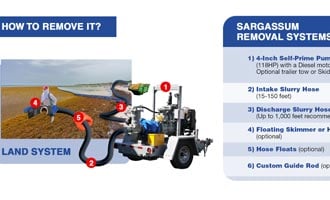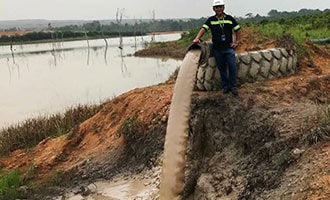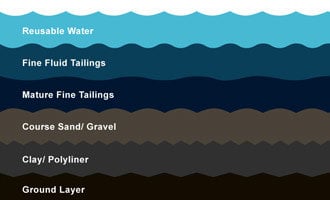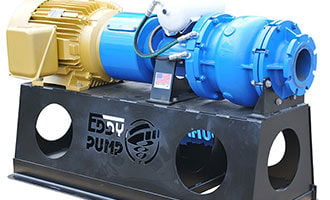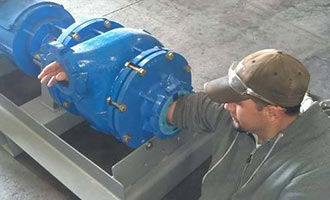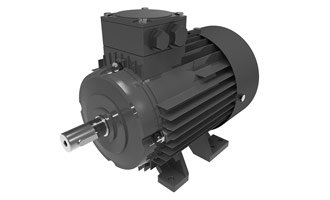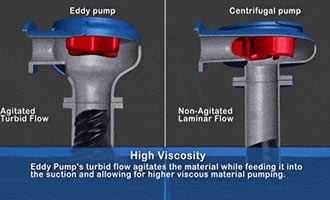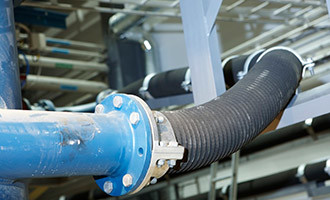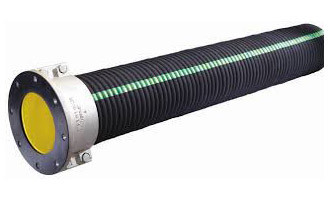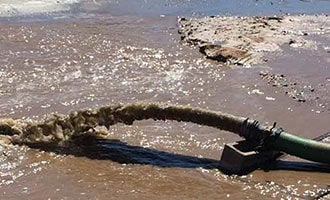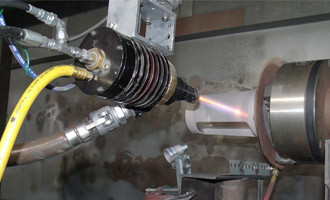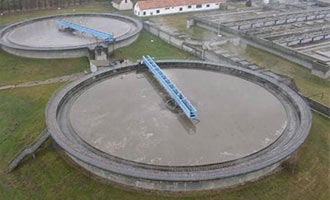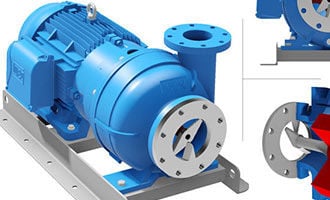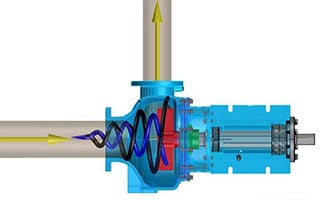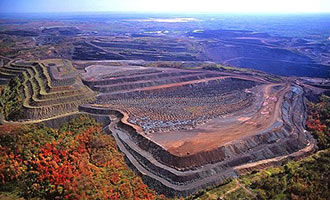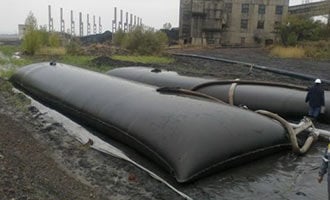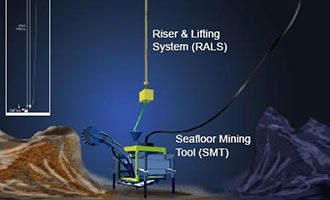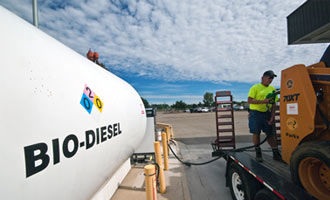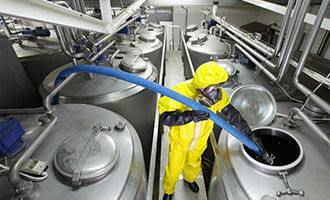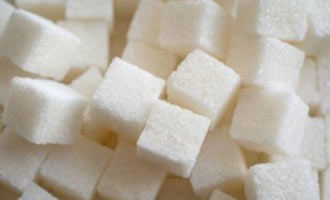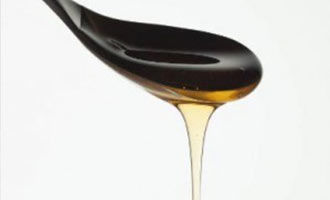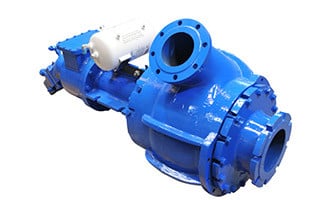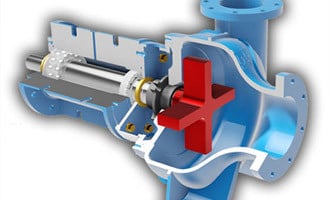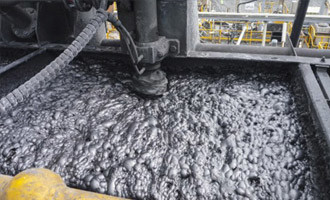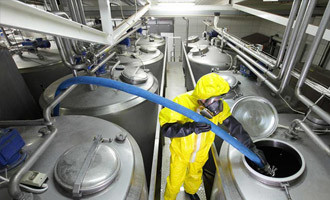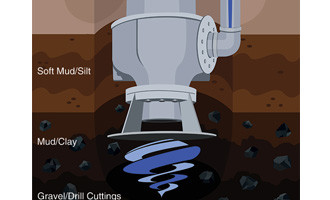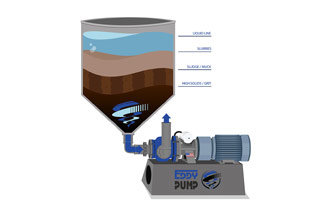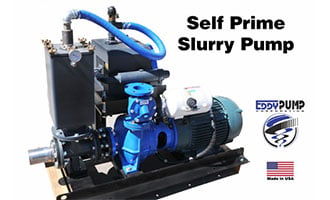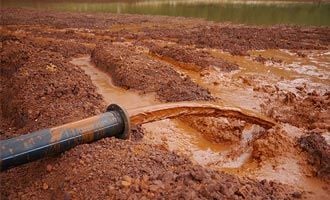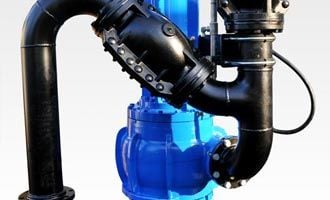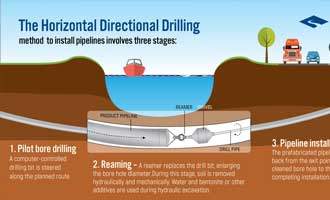Slurry Pipeline Friction Loss Explained
Learn about pipe friction loss; why it is so important regarding flow rate, and why it is so important when designing a pipeline for a slurry application. Browse Our Slurry PumpsContact us for a Fast Quote- Reasons for Slurry Pump Pressure Drop
- Calculating Pipeline Friction Loss
- Friction Loss Equations
- Choosing Pipe Sizes
- What Makes the EDDY Pump the Top Choice for Pumping Solids
When a fluid or slurry is being pumped through a pipeline the fluid begins to lose momentum due to a decrease in velocity of the fluid. This decrease in velocity is called pipe friction loss. Pipe friction loss occurs due to friction between the fluid being pumped and the inside walls of the piping. For an analogy that helps to explain pipe friction loss, think of a river. As a river flows the water that flows along the river bank flows at a slower rate than the water in the middle. This is due to the water coming into contact with the material that makes up the riverbank, which causes drag. This same effect occurs inside of the piping when a material is being pumped through a piping system. Pipe friction loss can also be described as resistance that affects the flow rate of the fluid being pumped. This resistance adversely affects pump efficiency and does not only occur when the fluid comes into contact with the inside of the piping; it is also caused by the fittings and bends that are installed into the pipeline which can negatively impact the critical line velocity that is needed to reduce the efficiency losses Pipe friction losses occur no matter what fluid is being pumped, but takes place to a greater degree when pumping slurry.
A great opportunity to reduce the effects of pipe friction losses is when designing a pipeline for a pump. The higher the flow rate required, and the smaller the piping results in greater losses in efficiency from resistance and pipe friction. This same thinking holds true for pipelines that include more valves, fittings, and bends. To avoid the negative effects of pipe friction loss, calculations can be performed to determine what pipe friction losses would be realized with a given fluid (higher viscosities have higher losses) to be pumped, desired flow rate, length, and pipe diameter, including valves, fittings, and bends.
Reasons for Slurry Pressure Drop
As fluid or slurry flows through a pipeline, a pressure drop can occur due to the resistance to flow. There could also be a pressure loss or gain due to elevation change from the beginning and end of the pipeline. This pressure resistance is a result of a number of issues:
- Friction between the slurry or fluid and the wall of the pipe
- Friction between layers and solids of the slurry itself
- Friction can also be lost as the slurry passes through any pipe fittings such as bends, valves, or other pipeline components
- If the pipe is not completely horizontal, pressure loss can occur due to the elevation of the pipe.
- Pressure gain due to any fluid head that is added by a pump
A Few Things to Consider to Reduce Pipe Friction Loss
- Reduce the length of piping.
- Increase the diameter of the piping.
- Reduce the surface roughness of the inside of the piping.
- Reduce the number of valves and bends.
Calculating Pipeline Friction Loss
There are numerous methods for calculating slurry pipeline friction losses, some methods being more complicated than others; every type of slurry can differ as far as density, particle size, and viscosity.
For this reason, it can be challenging to accurately predict precise friction losses when calculating for slurries. Most simpler methods work better when dealing with shorter pipelines, while longer pipelines require more meticulous planning, calculations, and proper testing for optimal flow rates.
A large portion of solids pumping applications occurs in dredging, mining operations, and processing plants which typically employ the use of shorter pipelines no longer than a few hundred feet with a relatively low static head. In most of these applications, it is typical to use simplified methods for predicting friction loss which can perform within 5% of the expected requirement of the slurry pump.
With slurry pumping, often times the characteristics of the slurry can change suddenly, requiring more or less power from your pump motor. For this reason, it is often recommended to select the initial pump motor with sufficient power reserve of up to 20% above the initial calculations. This extra power can make or break an operation dealing with tougher slurries or solids than originally expected. Although more expensive, a larger motor can help prevent pipeline clogs and other severe maintenance issues when pumping tough solids or other materials.
Friction Loss Equations
Friction losses are calculated based on three types, namely when pumping:
(1) liquids
(2) homogeneous slurries of fine non-settling solids
(3) heterogeneous slurries of larger (settling) solids.
When pumping, pipeline friction losses are typically calculated differently depending on whether the material is:
1) Liquid (No solids present)
2) Homogeneous (Uniform particle sizes) slurries of fine non-settling particles
3) Heterogenous (Diverse in particle sizes) slurries of larger settling solids
Liquid friction losses are calculated by the Darcy or Hazen-Williams methods, while non-settling homogeneous slurry losses are calculated by the Bingham slurry method. Settling slurries require more rigorous calculation methods and testing.
Darcy Calculation: Q = -KA dh/dl
Where:
Q = rate of water flow (volume per time)
K = hydraulic conductivity
A = column cross-sectional area
dh/dl = hydraulic gradient, that is, the change in head over the length of interest.
Hazen-Williams Equation: V = k C (D/4)0.63 S0.54 where S = hf / L
Where:
V = velocity
k = a conversion factor for the unit system (k = 1.318 for US customary units, k = 0.849 for SI units)
C = a roughness coefficient
R = the hydraulic radius
S = the slope of the energy line (head loss per length of pipe or hf/L)
What Makes the EDDY Pump the Top Choice For Pumping Solids?
The EDDY Pump is an excellent choice at moving heavy solids and other materials through long pipelines. The EDDY Pump creates a turbulent flow that helps keep the heavy materials in suspension and moving down the pipeline. The EDDY Pump rotor acts as a mixer on thixotropic materials and provides a shear thinning effect. The EDDY Pump’s ability to pump concentrated solid material is perfect for moving viscous materials with less than 5% free liquid; an impossible task for centrifugal pumps.
With the EDDY Pump, you’ll pump less water and more solids which can lead to huge cost savings. To move the same amount of material as traditional pumps, the EDDY Pump will be smaller in size, lighter in weight, use less power and cost less than conventional equipment. Further, there is no critical setup, eliminating the expense of balancing and alignment that other pumps incur.
EDDY Pump has dedicated engineers for pump modeling and analysis based on whatever material that needs to be pumped or dredged. We can go from concept to modeling to pumping out a 3D printed test unit within 48 hours. Heavy investments have been made in hardware and software to assist the EDDY Pump research team.
Our comprehensive knowledge of fluid dynamics as it relates to pumps combined with our experience in structural engineering allows us to provide completely optimized pumps and dredging equipment with adjoining pipelines and hoses. Our research and development team utilize computational fluid dynamics (CFD) software to accurately calculate flow uniformity across the entire system.
At EDDY Pump, we are constantly striving to improve and innovate new technologies to incorporate into our pump and dredging equipment.
NEW – Best Applications – Industries Most Served
The EDDY Pump Corporation is a premier manufacturer of pumping and dredging equipment. If you are pumping or dredging slurry, high solids, extremely viscous material, paste, high abrasives (sand & gravel) and material filled with solids, then you found the best suited product for the job. Go to: https://eddypump.com/ or Call Us!
Mining, Fly Ash, Coal Ash, Oil, Fracking, Gas, Wastewater, Pulp and Paper, Chemical, Energy, Water Municipalities, Irrigation, and Dredging Companies. For Access to Complete Product Line Go to: https://eddypump.com/products/
Order or Get Pump Selection Help
Let our sales or engineering support help in your slurry pump selection process. Call (619) 258-7020
Why EDDY Pumps Are Better – Highlights
This video shows how EDDY Pump transports high slurry and abrasive materials. Featured dredge pump equipment includes the Remote Operated Subdredge, Diver Operated Pump and a Excavator Attachment Dredge Pump.
Why EDDY Pumps Are Better - Highlights
This video shows how EDDY Pump transports high slurry and abrasive materials. Featured dredge pump equipment includes the Remote Operated Subdredge, Diver Operated Pump and a Excavator Attachment Dredge Pump.


